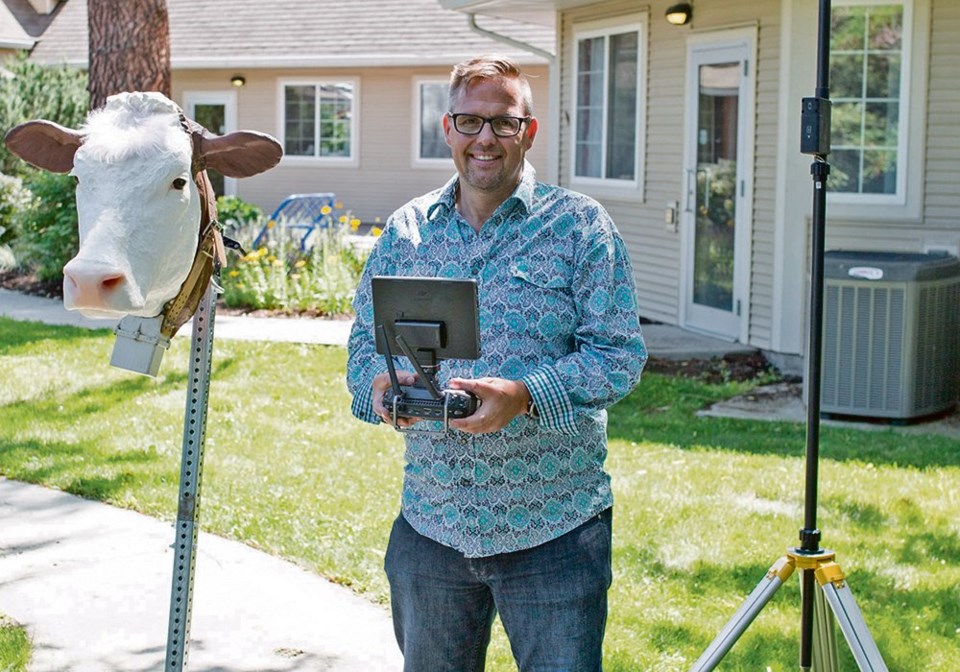Canadian beef producers must start breeding cattle that will better cope with increasing weather extremes of heat and cold caused by climate change, says a researcher.
Although they’ve been bred for traits such as improved feed efficiency, “I don’t think we’ve spent enough time thinking about the impact of what climate change might mean for the predominate cattle breeds,” said John Church, B.C. Regional Innovation Chair in Cattle Industry Sustainability at Thompson Rivers University in Kamloops.
Black Angus cattle have become popular in the past few decades but they are “probably also pretty susceptible to the future impacts of climate change,” said Church.
Through research using drones and thermal cameras, it’s been shown that black-coloured coats heat up much more than other coats, such as white or red.
Church likened it to how people who wear white T-shirts in July or August don’t suffer from heat as much as people with black T-shirts. “And there’s no doubt that the black coat colour is a detriment when you’re talking about heat stress and climate change.”
However, the preference for such cattle has become so strong among producers that breeds that aren’t traditionally thought of as black are being switched, said Church, who is also an associate professor in the university’s natural resource science department.
The trend is occurring despite the fact it is not linked to factors such as growth rate or carcass quality that impact the bottom line of producers, “so I think to a certain extent the coat colour that animals have are more fashion than anything else.”
Climate change is catching up to producers much faster than what was once predicted, said Church. He warned the Canadian Senate’s standing committee on agriculture and forestry in 2018 that the interior of B.C. would likely see temperatures as high as 48 C by 2030, not 2050 or 2100 as some senators anticipated, sparking shock and even disbelief.
Only three years later, Lytton, B.C., was destroyed by wildfire on June 30, the day after the village set a Canadian record of 49.6 C due to a heat dome that covered much of western North America. Cattle facing such conditions can die, said Church.
“I was out monitoring cattle in our ranch near Kelowna … and they were showing signs of heat stress I’ve never observed before, so it went way beyond even just open mouth breathing and excessive panting. I actually started seeing cattle shivering, shaking, and that’s hyperthermia as opposed to hypothermia, and I had never really observed that before.”
He was also surprised by how little temperatures cooled at night. Cattle can “probably handle a lot of heat during the day, but they need the nighttime temperatures to become cooler so that they can dissipate some of that heat, and we just didn’t see that.”
Cattle facing prolonged heat can also experience declines in their average daily gain, which occurs long before the animals die, “and I think that’s emerging across North America,” he said.
Technology that tracks feed intake at feedlots is demonstrating that heat stress is becoming a much bigger problem than was previously thought, he said. It can cause long-term changes to things such as the digestive tracts of cattle that can result in lengthier finishing times, “so rather than taking 120 or 160 days, it’s now going to take you 180 or 190 days.”
It means cattle will need to be fed for longer periods due to heat waves and accompanying drought that also tends to reduce their sources of feed, he said. Cattle reproduction will also be affected as they try to avoid the heat.
Climate change is causing what formerly might have been once in a millennium weather events to be “maybe once every 10 years or once every five years,” said Church. “Pretty soon, keep adding more CO2 in the atmosphere and it will be every three years, or we’re dealing with that every other summer, right?”
Although it likely will be some time before producers forget the heat dome of June 2021, Church said it is important to also remember a polar vortex occurred only about five months earlier in February. It sparked a continent-wide cold snap as far south as Mexico that set several records across the prairie provinces.
Canadian producers need to breed cattle that can better handle widely different temperature extremes while maintaining traits such as feed efficiency and meat quality, he said. There are some clear, naturally occurring mutations in various breeds around the world that haven’t yet been commercially exploited that need to be investigated, said Church.
“What I am proposing is, can we take animals that are more cold hardy and combine them with the traits from animals that are more heat tolerant, or are they mutually exclusive? But most of the past evidence seems to suggest it might well be possible to merge the two together.”

